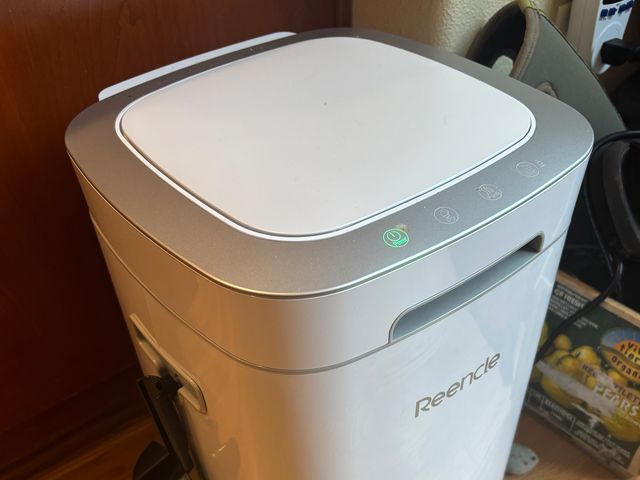The countertop kitchen composter is a lovely vision. Instead of a smelly bucket of vegetable scraps and coffee grounds breeding fruit flies on your counter or attracting rats to your backyard, you could just put it all into a nifty electric gadget, and at some undetermined point in the future you’ll have a bountiful supply of nutrient-rich compost to use in your garden.
Unfortunately, none of the more popular electric machines on the market do this. Even though some of these devices are marketed as “composters” and have instruction booklets and apps detailing all the ways in which one can use compost, the vast majority of kitchen composters are just going to grind up and dry your food scraps. Your waste output will be greatly reduced in volume and will no longer smell, but if you’re hoping to put eggshells and banana peels into a machine and magically scoop out the kind of true compost you’d buy at the garden center, that’s just not going to happen.
That said, you can mix small amounts of these grounds into potting soil in very small ratios, or use them as feeder for a “real” compost pile, but most of these machines are meant for those wanting to reduce the volume of food waste their household produces. Which is in and of itself a legitimate goal, as cast-off food makes up 24 percent of municipal solid waste, resulting in the release of methane, a destructive greenhouse gas, as it breaks down in the landfill.
Or maybe you’d just like your food grounds to be odor-free and shelf-stable before adding them to your green waste bin for municipal composting or your backyard compost. In any case, despite critics’ cries of greenwashing and corporate astroturfing, there is still value to these devices. They make people more aware of their food waste. They don’t use as much power as you think they would (around 1 kilowatt-hour was typical). And our top pick, the Reencle Prime (read our full review here), even produces something close to compost.
Read on for our assessment, and once you’re done, check out some of our other kitchen-related guides, including Best Coffee Makers, Best Toaster Ovens, Best Meat Subscription Boxes, and Best Meal Kit Delivery Services.
Updated October 2025: We’ve added Lomi’s newest model and removed a discontinued composter, rearranged the layout of this article, and ensured up-to-date links and prices.
Table of Contents
Best Overall
As previously mentioned, none of these machines make truly ready-to-use compost, but the (read our full review here) comes closest to a traditional compost bin. Popular in South Korea years before it appeared in the US, the Reencle arrives with a starter bag of ReencleMicrobe (which can be purchased separately for $65) containing activated carbon, wood pellets, glucose, and a trio of patented microbes ready to chow down. There’s also a prefilled carbon filter that slots into the back.
Photograph: Kat Merck
At 14 x 15 x 22 inches, the Prime is too large for a kitchen counter but instead conveniently operates much like a heated trash can. The lid can be opened via sensor at the bottom or a button on the control panel, and in goes your organic matter. That’s it. There are no cycles, tablets, or auxiliary buckets to worry about. Even the app is totally optional. Within hours to days, depending on the item, the scraps are broken down into a material resembling a cross between dirt and sawdust.
The smell isn’t always pleasant, but it can usually be mitigated by the control panel’s Dry and Purify buttons or by adding what in composting lexicon is called “browns”—dry, carbon-rich materials like bread or shredded paper.
Photograph: Kat Merck
The Reencle also tends not to smell when it’s being fed its preferred diet of 1.5 pounds of scraps per day. Unlike other machines, it can also accept meat and dairy. For larger households, there’s the Reencle Gravity ($649), which is a couple of inches taller and can accept 3.3 pounds of waste a day. I also tested this and found it to be significantly quieter than the Prime—not that the Prime is noticeably loud, only about 30 or so decibels, but the Gravity is nearly silent, which is a nice bonus.
When the volume reaches the fill line, the Reencle grounds can be scooped out and added at a 1:4 ratio with potting soil, then left to cure for three weeks (I used a large tub in my garage), after which it can be used for both outdoor and indoor plants. I have used this resultant mix to positive effect both indoors and outdoors.
Services Marketplace – Listings, Bookings & Reviews

-Reviewer-Photo-SOURCE-Kat-Merck.jpg)

